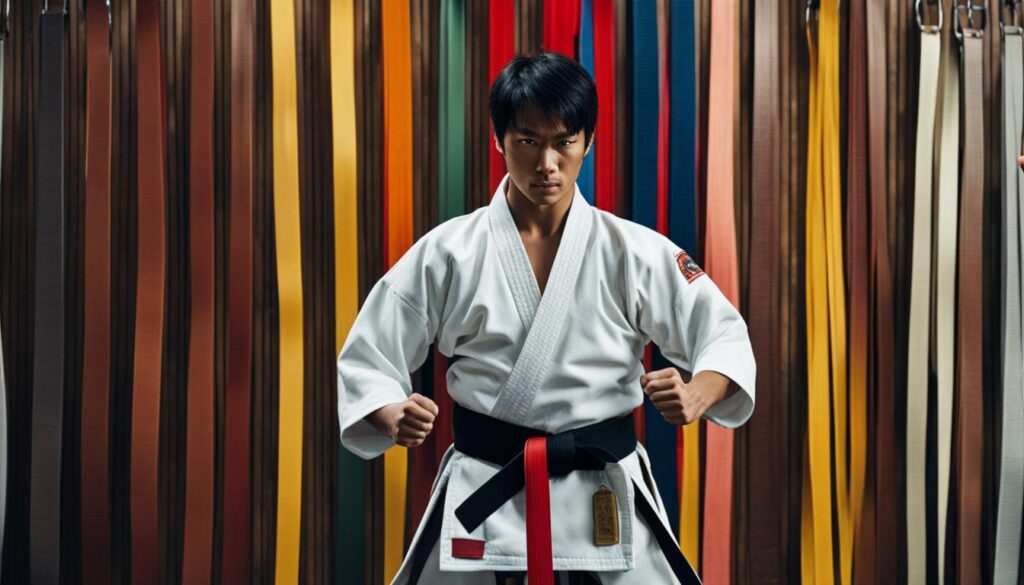Karate is a beloved martial art that has captivated the world with its disciplined techniques and rich history. It provides a pathway for individuals to develop physical strength, mental focus, and a strong sense of self. Central to the tradition of Karate is the belt system, which is used to signify a student’s progress and rank. In this article, we will delve into the fascinating world of Karate belts, exploring the different belt levels, colors, and the journey they represent.
Key Takeaways:
- Karate utilizes a belt system to signify a student’s progress and rank.
- There are different belt levels and colors in Karate, each representing a different level of skill and experience.
- The belt order in Karate follows a specific progression, from white to black.
- A black belt is the highest rank in Karate, but there are also different degrees of black belt that can be achieved.
- The belt system in Karate promotes personal growth, discipline, and self-improvement.
The History of Karate and Belt Colors
Karate, a Japanese martial art, has a rich and ancient history that dates back centuries. Its origins can be traced to techniques learned from Chinese Shaolin monks, who migrated to Okinawa, Japan. Through centuries of refinement, Karate evolved into a distinct martial art with its own set of principles, forms, and techniques.
One notable aspect of Karate is the use of colored belts to signify a student’s progress and skill level. Contrary to popular belief, the story that the color of belts darkens with increasing martial arts knowledge is an urban myth. The practice of colored belts in Karate can be attributed to Dr. Jigoro Kano, the founder of Judo, in the late 19th century.
Rather than indicating mastery, colored belts were introduced in the 1930s as a means of recognition and distinction among students of varying skill levels. The belt colors in Karate provide a visual representation of a student’s advancement and serve as a source of motivation and encouragement throughout their martial arts journey.
Today, the colored belt system in Karate consists of nine solid colors, ranging from white to black. Each color represents a different level of proficiency and experience, with black belt being the highest level achievable. However, it’s important to note that achieving a black belt is not the end of a martial artist’s journey, but rather the beginning of a new phase of advanced training and learning.
The Karate Belt Order and Meaning
In Karate, the belt order follows a specific progression from white to black, with each color belt representing a different level of skill and experience. While the exact order may vary slightly between different Karate styles, the general principle remains consistent – the belt becomes darker as the student progresses.
The symbolism of the belt colors in Karate is significant. They represent the growth, proficiency, and mastery of the martial art. Each belt level signifies the development and improvement of the practitioner’s techniques, discipline, and understanding of Karate.
It is important to note that achieving a black belt in Karate is not the endpoint of a martial artist’s journey. Instead, it marks the beginning of a new phase of advanced training and learning. The black belt serves as an indication of a student’s dedication, perseverance, and commitment to continuous improvement in the art. It symbolizes the start of the mastery stage, where the practitioner can delve deeper into the intricacies of Karate.

Note: The image above depicts the traditional Karate belt order, from white to black.
The Journey of a Karate Student
Embarking on the journey of becoming a Karate student is an exciting and fulfilling endeavor. It is a path of self-discovery, discipline, and personal growth. As in any martial art, the journey begins with a blank slate, symbolized by the white belt.
When a beginner first steps into the dojo, they are introduced to the fundamentals of Karate. They learn basic techniques, stances, and forms under the guidance of an experienced instructor. This initial phase is crucial for building a strong foundation.
As the student progresses and demonstrates proficiency in the basics, they are awarded different color belts, each representing a higher level of skill and knowledge. The progression through the belt levels in Karate is an acknowledgment of the student’s dedication, hard work, and improvement.
To give you an idea of the karate belt levels, here is a list of the most common progression:
Karate Belt Levels
| Belt Color | Rank |
|---|---|
| White Belt | Beginner |
| Gold Belt | Advanced Beginner |
| Green Belt | Intermediate |
| Purple Belt | Intermediate |
| Blue Belt | Intermediate |
| Red Belt | Advanced Intermediate |
| Brown Belt | Advanced Intermediate |
| Black Belt | Expert |
It is essential to understand that progressing through the belt levels is not a race, but a journey that takes time, effort, and dedication. Gaining a black belt, the highest rank in Karate, is often viewed as a significant achievement. However, it is important to remember that the journey does not end there. In fact, achieving a black belt marks the beginning of a new phase of advanced training and continuous learning.
The training process in Karate involves rigorous physical conditioning, technical practice, and mental discipline. It requires perseverance, focus, and resilience. Over the years of training, a Karate student learns not only self-defense techniques but also valuable life skills such as self-discipline, respect, and perseverance.
Ultimately, the journey of a Karate student is a deeply transformative experience. It is a path that shapes character, builds confidence, and fosters personal growth. Throughout this journey, the student learns to overcome challenges, push boundaries, and unlock their full potential.
The Significance of Each Karate Belt Color
In Karate, the belt colors hold deep symbolism and represent the various stages of a student’s journey in this martial art. Each belt color signifies a different level of proficiency and growth, providing a clear visual representation of a practitioner’s progress.
The white belt is the starting point in Karate and represents a beginner student. Just as a blank canvas holds infinite possibilities, the white belt symbolizes the eager willingness to learn and embark on the path of Karate.

As the student advances, they transition to the gold belt. This belt signifies the evolution and progress in their training, as well as an introduction to a more advanced curriculum. It is seen as a stepping stone towards higher levels of mastery.
Once the student reaches the green belt, they enter a phase of growth and development. At this level, practitioners may be introduced to sparring or controlled contact fighting, further enhancing their skills and building their confidence.
The purple belt represents a deeper level of understanding and knowledge in Karate. Practitioners at this stage have honed their techniques and are capable of executing them with precision. This belt symbolizes a commitment to continuous learning and improvement.
The blue belt represents the refinement of learned techniques. At this stage, students gain a deeper understanding of the underlying principles and concepts of Karate. They refine their movements, focusing on precision and control.
The red belt is an emblem of the highest level of skill and advanced techniques. Students who have attained this rank possess immense strength and proficiency. The red belt signifies the culmination of years of dedicated training and represents a significant milestone in their Karate journey.
Finally, the brown belt indicates a student’s maturity and readiness to enjoy the fruits of their efforts. It reflects their ability to apply their skills in various situations and showcases their dedication to the art of Karate.
Each karate belt color brings its own significance, highlighting the progress and growth of the practitioner. As a student progresses through the belt levels, they cultivate discipline, resilience, and determination, ultimately embodying the essence of Karate.
Achieving the Coveted Black Belt
The black belt is the ultimate achievement in the Karate belt order. It represents the highest level of skill, knowledge, and dedication in the martial art. However, earning a black belt is not an easy feat. It requires several years of focused training and practice to reach this prestigious rank.
To achieve a black belt in Karate, students must meet specific requirements set forth by their dojo or Karate organization. These requirements may vary, but they often include:
- Demonstrating proficiency in basic techniques, forms, and sparring.
- Showcasing a deep understanding of Karate’s principles and philosophies.
- Participating in regular training sessions and attending classes consistently.
- Exhibiting discipline, respect, and a strong work ethic.
Throughout the journey towards a black belt, students undergo rigorous training and face numerous challenges. Each belt level serves as a stepping stone, building upon the skills and knowledge acquired in previous ranks. Students must demonstrate continuous improvement and dedication to progress through the belt system.
Upon achieving a black belt, a student is recognized as having a broad competence and understanding of Karate. However, the journey doesn’t end there. The black belt itself has multiple degrees, ranging from 1st dan to 10th dan. Each degree represents a higher level of proficiency and expertise, requiring additional years of training and dedication to attain.
The pursuit of a black belt in Karate is a lifelong journey that goes beyond physical skill. It encompasses personal growth, discipline, and a deep connection to the art. Achieving a black belt is not just about obtaining a rank; it is about embodying the values and principles of Karate both inside and outside the dojo.
Whether it takes four years or ten, earning a black belt is a significant accomplishment that reflects a student’s commitment and passion for Karate. It represents the culmination of years of hard work, sacrifice, and a relentless pursuit of excellence. The black belt is not just a symbol; it is a testament to the indomitable spirit and unwavering dedication of the martial artist.
The Dan Ranks in Karate
The dan ranks in Karate represent advanced levels of expertise and are achieved after significant years of training and dedication. While the first-degree black belt may be seen as an expert in self-defense, among the fraternity of black belts, they are considered a beginner. As a student continues to progress through the dan ranks, they must undergo additional training and demonstrate mastery of the art. Each degree, from 2nd dan to 10th dan, signifies a higher level of skill, knowledge, and leadership within the martial arts community.
One of the key distinguishing factors in the dan ranks is the demonstration of mastery. Karate practitioners who have reached higher dan levels possess an in-depth understanding of the art, its techniques, and its principles. These advanced practitioners often take on leadership roles, guiding and instructing students who are at lower ranks.
Below is a table that provides a visual representation of the dan ranks in Karate:
Belt Rankings in Judo
Judo, a martial art that originated in Japan, has its own belt ranking system to recognize a practitioner’s progress and skill level. While the traditional system initially used only black and white belts, many schools and styles have since adopted more comprehensive ranking systems. The belt order in Judo typically follows a progression from white to black, with various color belts in between representing different levels of skill and knowledge.
In Judo, the belt order starts with the white belt, symbolizing a beginner. As a practitioner advances, they progress through belts of increasing complexity and importance, each requiring rigorous testing and evaluation. The order of belt colors in Judo commonly includes yellow, orange, green, blue, purple, brown, and finally black.
Promotions in Judo are not only based on technical ability but also encompass values such as attitude, knowledge, and dedication to the art. These promotions often involve demonstrations of techniques, sparring skills, and understanding of Judo principles. The specific requirements for each belt ranking may vary among different Judo schools and styles.
Below is a table illustrating the belt order in Judo:
| Belt Color | Rank |
|---|---|
| White | Beginner |
| Yellow | 8th Kyu |
| Orange | 7th Kyu |
| Green | 6th Kyu |
| Blue | 5th Kyu |
| Purple | 4th Kyu |
| Brown | 3rd, 2nd, and 1st Kyu |
| Black | 1st Dan and beyond |
Ranking up in Judo is an exciting and fulfilling journey, signifying a practitioner’s growth and mastery of the art. Each belt represents countless hours of training, dedication, and commitment to the principles of Judo.

Belt Rankings in Brazilian Jiu-Jitsu
Brazilian jiu-jitsu, an offshoot of judo, follows a belt ranking system to track a practitioner’s progression and skill level. The belt order in Brazilian jiu-jitsu is as follows:
- White Belt: The starting point for all students, representing a beginner level.
- Blue Belt: The second belt in the hierarchy, symbolizing the transition from beginner to intermediate.
- Purple Belt: The third belt, indicating a deeper understanding and mastery of Brazilian jiu-jitsu techniques.
- Brown Belt: The fourth belt, showcasing advanced skill and proficiency in the art.
- Black Belt: The ultimate symbol of expertise and dedication in Brazilian jiu-jitsu.
Unlike other martial arts, Brazilian jiu-jitsu does not have kyu ranks. Instead, the black belt signifies an expert level in the practice. However, within the black belt, practitioners can achieve additional degrees through years of training, demonstrating their commitment to the art.
Belt Rankings in Taekwondo
Taekwondo, a Korean martial art, employs a belt ranking system that signifies a student’s progression and skill level. The taekwondo belt order follows a structured hierarchy, starting with the white belt and advancing through yellow, orange, green, blue, purple, brown, and ultimately black. Each belt color represents a different level of proficiency and knowledge in the art.
Students earn promotions to higher belt ranks through rigorous testing and evaluation, which assesses their technique, forms, sparring, and overall understanding of taekwondo principles. These evaluations ensure that students are prepared to take on the challenges and responsibilities associated with their new rank.
Beyond the belt colors, taekwondo incorporates various levels such as beginner, intermediate, and advanced. These levels further highlight a student’s overall skill, experience, and commitment to the martial art.
Image:

The Importance of Belt Rankings in Martial Arts
Belt rankings play a crucial role in martial arts, serving multiple purposes in a student’s journey. These rankings provide a clear measurement of a student’s progress and skill level, offering tangible goals to strive towards. As students advance through the belt levels, they gain a sense of achievement and motivation to continue their training and improvement.
Belt rankings also serve as an indication of a student’s readiness to learn more advanced techniques and take on greater responsibilities within the martial arts community. Each belt color represents a different level of achievement and experience, showcasing a student’s dedication and mastery of the art. This allows instructors to identify students who are ready for new challenges and provides a framework for curriculum development.
Beyond individual progression, belt rankings foster camaraderie and respect within martial arts schools. Students at different belt levels are encouraged to support and learn from each other, creating a cooperative and encouraging environment. The visible distinction of belt colors allows students to acknowledge and appreciate the accomplishments of their peers, promoting a sense of community and shared goals.
The Process of Belt Promotion in Martial Arts
In martial arts, the process of belt promotion plays a crucial role in recognizing a student’s progress and skill level. It involves a series of tests and evaluations to determine if a student is ready to advance to the next belt rank. These tests assess various aspects of the student’s martial arts journey, including their technical skills, forms, sparring abilities, and understanding of the art’s philosophy and principles.
During the belt promotion process, students are typically required to demonstrate their proficiency in executing techniques accurately, showcasing their knowledge of forms, and displaying effective sparring skills. These tests serve as an opportunity for students to showcase their growth and development throughout their martial arts training.
However, belt promotion is not solely dependent on physical abilities. Some schools also consider factors such as attendance, attitude, and dedication to the art when determining a student’s readiness for promotion. These additional considerations ensure that students embody the core values of martial arts, such as discipline, respect, and perseverance.
The process of belt promotion serves several purposes. Firstly, it helps students set goals and work towards achieving them. Each belt rank becomes a milestone in their martial arts journey, marking their progress and motivating them to continue training and improving their skills.
Additionally, belt promotions enable students to track their progress and measure their growth over time. By moving from one belt rank to the next, students can see how far they have come and take pride in their achievements.
Furthermore, belt promotion provides a sense of accomplishment and celebration for students. When students successfully pass their belt tests and receive their new rank, it is a moment of joy and recognition for their hard work and dedication.

The process of belt promotion in martial arts is a journey of self-improvement and personal growth. Through dedicated training, students develop not only physical skills but also mental and emotional resilience. The belt system serves as a tangible representation of their progress, marking their commitment to the art and their ongoing pursuit of excellence.
The Martial Arts Belt System and Personal Growth
The martial arts belt system is not just a symbol of a student’s progress and skill level, but also a catalyst for personal growth and self-improvement. As individuals progress through the different belt levels, they are not only honing their physical abilities but also developing important life skills and qualities.
One of the key benefits of martial arts training is the cultivation of discipline. Through the rigorous training routines and adherence to the principles of the art, students learn to discipline their minds and bodies. This discipline extends beyond the training mat and seeps into all aspects of their lives, helping them become more focused, organized, and self-motivated.
Perseverance is another invaluable trait that is nurtured through the belt system. As students face challenges and setbacks on their martial arts journey, they learn to push through difficulties, stay committed to their goals, and never give up. This resilience not only serves them well in their training but also in their personal and professional lives.
Martial arts training also fosters a sense of confidence and self-belief. As students progress through the belt levels, they witness their own growth and improvement, which boosts their self-esteem. The belief in their abilities extends beyond the martial arts context, empowering them to take on challenges and pursue their goals with conviction.
Moreover, martial arts training instills important values such as respect, humility, and resilience. Students learn to respect their instructors, training partners, and the art itself. They also become humble in their achievements, recognizing that there is always more to learn and room for improvement. This humility spills over into interactions with others, fostering positive relationships and a sense of community.
The belt system serves as a visual representation of an individual’s dedication to their craft and their ongoing journey of self-improvement. Each belt earned signifies not only the mastery of new techniques and skills but also the personal growth and transformation that comes with it.
Overall, the martial arts belt system provides a platform for personal growth, self-improvement, and the cultivation of important life skills. It goes beyond physical prowess and serves as a vehicle for developing discipline, perseverance, confidence, and valuable character traits. Through the belt levels, students embark on a journey of continuous learning and self-discovery, reaping the benefits both on and off the training mat.
Conclusion
The belt system in martial arts, particularly in karate, is a powerful representation of a student’s journey and growth within the art. From the initial white belt of a beginner to the coveted black belt of an advanced practitioner, each belt signifies progress, skill, and dedication. The different colors of the belts hold their own significance, symbolizing growth, knowledge, and mastery.
More than just a measure of progress, the belt system in martial arts serves as a pathway to personal development and self-improvement. As students progress through the ranks, they not only acquire physical skills but also develop important qualities such as discipline, perseverance, focus, and confidence. Martial arts training fosters values like respect, humility, and resilience, which extend beyond the training mat and into everyday life.
The belt system is a visual representation of an individual’s commitment to their craft and their ongoing pursuit of excellence. It provides a clear roadmap for students to set goals, track their progress, and celebrate their achievements. As martial artists move through the belt levels, they embark on a continuous journey of personal growth and self-discovery. Whether it is in karate or any other martial art, the belt system stands as a testament to the transformative power of martial arts training.
FAQ
How many belts are there in Karate?
There are nine solid color belts in Karate, ranging from white to black.
What do the different belt colors in Karate represent?
Each belt color in Karate represents a different level of skill and experience.
What is the order of the belts in Karate?
The belt order in Karate generally progresses from white to black, with variations between different styles.
How long does it take to achieve a black belt in Karate?
It takes several years of consistent practice and training to reach the level of a black belt in Karate.
How many degrees are there in a black belt?
There are multiple degrees of black belt in Karate, ranging from 1st dan to 10th dan.
What are the dan ranks in Karate?
The dan ranks in Karate represent advanced levels of expertise and are achieved through significant years of training and dedication.
What is the belt order in Judo?
The belt order in Judo typically starts with white and progresses through yellow, orange, green, blue, purple, brown, and black.
How does Brazilian jiu-jitsu’s belt ranking system work?
Brazilian jiu-jitsu uses a belt ranking system starting with white and progressing through blue, purple, brown, and black.
What is the belt order in Taekwondo?
The belt order in Taekwondo typically goes from white to black, with various colored belts in between representing different levels of proficiency.
What is the significance of belt rankings in martial arts?
Belt rankings provide a clear measurement of a student’s progress, signify readiness for advanced techniques, and promote camaraderie and respect among students.
How are belt promotions determined in martial arts?
Belt promotions usually involve testing and evaluation of techniques, forms, sparring skills, and knowledge of the art’s philosophy and principles.
How does the martial arts belt system contribute to personal growth?
The belt system in martial arts promotes discipline, perseverance, focus, confidence, and instills important values such as respect, humility, and resilience.
What is the journey of a Karate student?
A Karate student progresses through different belt levels, gaining skill, knowledge, and maturity through consistent practice and dedication.
What is the significance of each Karate belt color?
Each Karate belt color symbolizes different levels of proficiency and represents growth, knowledge, and mastery in the martial art.
What is the history behind the use of colored belts in Karate?
The use of colored belts in Karate began in the 1930s to provide recognition and distinction between beginner, intermediate, and advanced students.
